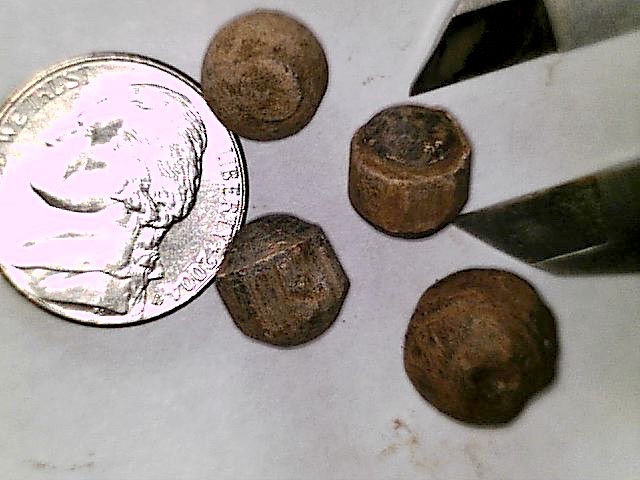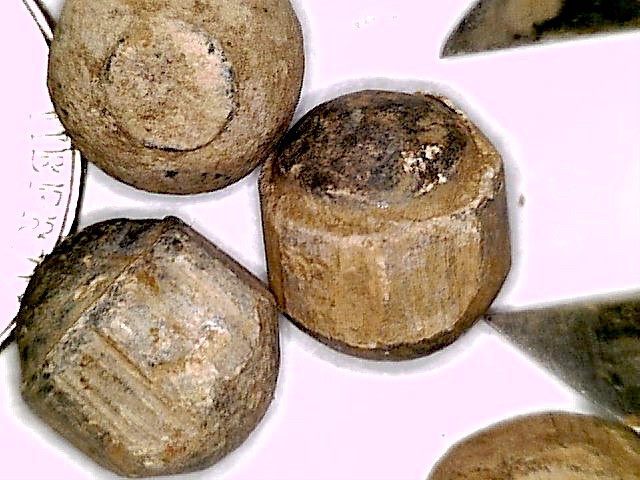
HardPack
Full Member-
Posts
610 -
Joined
-
Last visited
Content Type
Forums
Detector Prospector Home
Detector Database
Downloads
Everything posted by HardPack
-
Anyone Prospect Near Tuscarora Nv?
HardPack replied to Lead Detector's topic in Detector Prospector Forum
Try this link: http://mylandmatters.org/ Go to “maps” on the top bar; on right side pick “mining claims”; then “state”. Once on the map use “+” to zoom. -
Been detecting these lead balls in or near 1850's California mining camps. The three (3) smaller ball measure 10 mm or 40 caliber at the rifling grooves. The larger ball 12 mm or 45 caliber at the rifling grooves. All of the balls appear to have been hand molded. Have detected the balls along the hillsides and in clusters at camp sites. Brush rabbits, blacktail deer and black bears were probable targets. Does anyone have an idea what type of firearms the old miners of 49 were shooting at the golden hills of California?
-
You might want look for any crossing between the iron bearing formation (dike) and any quartz stringers in the area. Iron has a higher attraction to sulfides than gold. Gold will form a weak bond with the sulfides under great pressure at depth. As a pulse of gold bearing silica solution moves towards the surface the pressure is decreasing. As the pressure decreases the already weak gold sulfide bond weakens further. At the crossings the iron will readily bond with the sulfides dropping out the gold. Usually at points where the quartz vein changes direction, dip or widens. There are a few pocket miners on the forum who can explain the process far better. Good luck
-
I need to grid off an area and start layering down to bedrock with the equipment on hand. PSWT sounds like something the VA should cover. I definitely have one of the symptoms and it ain’t the “P”.
-
A common characteristic of the 1850 placer sites is the flatten rusted tin. The miners would dump their individual trash into the nearest gully. Over the years the trash has spread out down slope. By listening to the iron falsing of the flatten rusted tin flows can lead an original camp site. Unfortunately, in many cases the ground under these camp sites was also flushed away in the search for gold. My SMF detector is great for tracking this type of iron falsing as long as the coil is not over sensitive to EMI. Rusted square nails, flatten stove pipe, shovel/pick heads, etc add to the underground puzzle. A DD coil can separate out non-ferrous targets hidden among rusted iron. The smaller the coil the easier the separating. But a buried blanket of rusted iron has to be effecting the detection depth of the DD coils. So would a 8” concentric coil mounted on either a SMF or single frequency VLF detector reach deeper into a level below this rusted debris field? There may be only one way to find out.
-
I recently put the 10x5 CT through a few field tests (smf vs emi) mounted on the end of a EQX 900. In heavy iron trash, ground balancing at 40 had no problem separating non-ferrous targets from ferrous. Site EMI was high and the CT coil picked up every bit. Finally backed sensitivity down to 16/18, Recovery 4/5 and Volume 20/22. Good coil in the brush but would not be my first choice for high EMI locations. I also tested the coil's trimming abilities on several nearby tree limbs, no knocks or loose connections were detected. The NOX 11 & Nox 6 handled the site EMI , ran stable and reached similar detection depths on this particular site.
-
I am very curious about the Vista X with a 8" concentric in iron trash drowning in EMI. Yesterday the 900 ground balanced on some 54 dirt. Have fun
-
Entering Into The "abyss"
HardPack replied to George Kinsey's topic in Metal Detecting For Coins & Relics
First video. The audio frequency is reaching the upper limits of my hearing. -
One more EMI trip. This time with the Nox 6 inch coil on the EQX 900. Used Auto Ground Balance (39-40 GB); stayed in Multi-Frequency in all search modes; Sensitivity 26. Same smooth results as with the Nox 11 inch in Park 1/2 and Field 1/2 modes. Dug two shallow modern dimes. In Gold modes 1 & 2: Multi-Frequency, Auto Ground Balance (different area same site 54 GB), Sensitivity 18, Volume 12, Recovery 1, Iron Bias 0, Threshold Level 12, Threshold Pitch 11, Target Tone 1, Accept/Reject -10 to 0, 1 to 99. No headphones, Smooth Threshold, no EMI, rejected TID -19 to -11 due to the excessive site ground signals in this range. Coil recap: with all search modes in Multi-Frequency: Coiltek 10x5 Nox very susceptible to EMI especially in the Gold modes; Nox 11 smooth in Park 1, Park 2, Field 1 & Field 2; susceptible to EMI in both Gold modes; Nox 6 smooth in all search modes. Ground tracking and Auto Ground Balance numbers were similar (39-40 GB).
-
I tried the EQX 900 gold modes with the 11 inch coil real quick today. Turned the volume down. It ran more stable than the 10x5 CT but still too much EMI for small target detection on this high EMI site. I’ll try your suggestions with the stock 6 inch coil early next week. But first an area cleared of all the buried iron trash for ground balancing is needed. Small & large rusted iron & tin buried everywhere. Bedrock is slate, no magnetite but a few hot rocks higher on the slope hitting the 1 & 2. Power plant and overhead high voltage lines four miles away. Yes, still have the XP Deus plus the 9 inch x35 & 9 inch HF coils. I’ll give the Deus a try after I finish drowning the multi-frequencies in EMI. Thanks
-
Minelab USA Price Increase Is Official. That Bites
HardPack replied to Gerry in Idaho's topic in Detector Prospector Forum
-
I have been monitoring the ground tracking numbers, between 39 & 40. I can set the GB manually. Already have the stock 6 inch coil ready for a run early next week if the weather holds. I’ll try pumping the coil then adjust if necessary. You got me thinking now. Whether ground tracking or pumping the coil over a carpet of rusted iron the detector is attempting to cancel all the ground noise including the buried iron under the coil. Even if completely successful the iron false positive signals are still going to bleed through creating a constant back ground noise. Plus the initial ground balance number will be off, probably on the high side. You’re right I need to bring the rake. Thanks for the advice.
-
Took the EQX 900 & 11 inch coil out to the EMI field of rusted dreams. In Park 1 started with single frequency 5 kHz, Recovery 4, Iron Bias 2. After Noise cancelling checked for EMI. Was able run the Sensitivity to 24 then 26 then 28. Little or no EMI. Ran the Recovery to 6, Iron Bias 4. Dug all targets to check detection depth pulled the upper portion of a rusted square nail at 8 inches. Switched to Multi-Frequency, Field 2, Recovery 3, Iron Bias 1. Noise cancelled then adjusted Sensitivity 22, 24 then settled on 26. Little or no EMI. Adjusted Recovery 4, Iron Bias 2, Sensitivity 26. Dug several more rusted square nails at 6 to 8 inches, several shallow boot tacks, shotgun brass. While running in discrimination I use the random TID spread of the false positive signals to identify buried iron. I may switch to All Metals to verify if in doubt. The TID numbers for 22 brass and lead are consistent enough that I no longer dig. Non-ferrous target signals jump out of the layered rusted iron. The EQX stock 11 inch is not as precise as the Coiltek 10x5 but sure operates far smoother in the presents of EMI. Also switched to the gold modes, lowered volume & sensitivity but still too much EMI interference. Discovered an old tent site perched up on the end of a rocky peninsula. The miners had removed the bench gravels on both the upstream and down stream side. A rock wall fire pit was all that remained setting 30 feet above bedrock along with two old pine trees. They did some nice stone work on the water ditch in this same area. Instead of piling rock next to the sluice runs it appears the mulchers pushed everything off the end into the creek bottom.
-
There is rusted tin everywhere, layered as if they ran it through a wood chipper before spreading. Plus flatten rusted tin cans, rusted square nails, rusted sheets, cast iron you name it. That why l was using ground tracking, there no areas free of rusted tin to pump the coil. So to deal with the EMI and to get a rough idea of detection depth I kept Recovery & Iron Bias low but ran only the Sensitivity up. I was able to cut a few non ferrous targets out of the dirt.
-
Probably need a Facebook account. I’m just getting the most popular videos. Interesting but not related to detecting. Jeff, Do you recall the ground balance number(s) you used? I have been having problems with EQX 900 in the gold modes (GB40) on a high EMI site. May be just the overall volume setting is set to high or the tone volume (12) ran the sensitivity down to 0, still to loud to detect small targets.
-
Yeah, I’ m trying the EQX 900 stock 11 inch coil on the old tent flats later today. Lots of down trees and brush. See how it handles the EMI. Been searching the web for a 40 caliber percussion cap rabbit gun. No luck so far.
-
Returned to detect the EMI site today. Started the day with Park 1 in the single frequencies, recovery 3, iron Bias 1. From 4kHz, 5kHz, 19 kHz & 15kHz. The EQX 900 was quiet. Had to switch to All-metal to make sure the detector was “On”. Did hear a few false positive signal in Discrimination. Ran the Sensitivity to 26 before picking up any EMI. At 20 kHz had to back off the sensitivity 22, at 40kHz the EMI was loud and clear Sensitivity 18. Did notice the EMI stopped with the coil in motion. Ground Balance 40, coil: 10x5 Coiltek Detected the remainder of the day in Multi-Frequency, Sensitivity 24, Recovery 4, Iron Bias 2. The EMI was jumping but decided to run hot. Ran through Park 1, Park 2, Field 1, then settled on Field 2. Again the EMI stopped when the coil was in motion. Plenty of false positive signals over iron. On the hillside picked up 8 intact 40 caliber (10mm) lead balls, 1 intact 44 caliber (12mm) lead ball, a piece fine wire and 2 half inch square pieces of metal which were not magnetic, pewter maybe, several modern lead bullets 22 to 30 caliber. Depth varied from 4 to 6 inches. Ground balance 40, Coil: 10x5 Coiltek
-
The Minelab Equinox 900 was released in December of 2022. Minelab Design Engineers have been aware the Equinox 900 design failures on a date no later than April 28, 2023. In December of 2023 in countless attempts to overcome the original design failures current owners of the Equinox 900 are still playing with settings in the field. Minelab design engineers are more concerned about job security, this is coming down from corporate. As illustrated by the re-release of Xterra 705 as the Xterra Pro in February 2023. Another stepping stone on the path to failure. Maybe we should be thinking class action.
-
That was a long and interesting read, can’t say it was a Minelab Equinox 900 confidence builder. I believe we both bought from Gerry about the same time, I am just now getting my 900 in the dirt. So far I have managed not to wrap it around a tree but there is always tomorrow. Good luck with the Manticore, for me I am finished with Minelab.
-
Several of you commented on the SMF vs EMI post, thanks for the input. Here is the back story of the detecting site impacted by all that EMI. During the 1850’s approximately 15,000 people occupied a relatively short drainage system flowing into a main river. Once the trails and supply lines were established and due to the low elevation placer mining could be conducted year round. Upstream are quartz outcroppings of the mother lode. However, along this lower drainage a major source of gold came from a basin higher upstream beyond the main lode deposits. The story goes that an old river flowing off a Nevada Plateau made large deposits into this upper river basin. Over the proceeding 55 million years younger streams came and went carving down through the upper basin carrying off some of these older deposits. In the early 1850’s prospectors located gold placers in bench gravels along the lower reaches. Soon thousands of miners were diverting water by means of numerous ditches and elevated wooden flumes to cascade water over these gold bearing terraces of concreted bench gravels. A trading post was established early on and the profits soared. Today located dead center of all this history is a hydro-electric power plant equipped with a switch yard and high voltage towers carrying away more mountain wealth to the coastal rich. The EMI of today is having a major impact on the leavings of yesterday, not to mention my attitude. Only the litter of rusted can goods commemorate the pack trains, trade goods and tent platforms of the golden past. The old bench placers are buried in vegetation, reptiles, felines and a washed in EMI. All this inhospitable has resulted in very little modern trash other than the remains of shooting into the darkest. Here’s my point regarding the impact of Electro Magnetic Interference (EMI) on Simultaneous Multi Frequencies (SMF) detectors. Site conditions have to be addressed in order to successfully detect targets whether it be ground mineralization, trash loads, UFO’s, etc. At this location EMI is only one of many site conditions. So my choices are to either to detect on another site or stay put and adjust settings. I can attempt to mitigate the site conditions with the detector in hand or switch detectors. I can change coil size, switching from a DD to a Concentric coil (might be a good option if only ability of a SMF VLF detector), adjusting the Sensitivity down, Recovery Speed up, repetitive Noise Cancelling, reduce target detection depth on deep targets and finally switch the SMF detector to a single frequency. All this effort spent on only one of the many site conditions, days are short and it is growing dark. Once the SMF setting is switched to a single frequency (SF) to address the site specific EMI erupting audibles the door swings completely open. And what do I see… Nexus, Deeptech, and a trusted White TDI SL with its “high tone/low tone switch knob” and folded mono coil. I am feeling better already. I think I’ll take this SMF detector for a day on the beach. Perhaps we’ll establish a better understanding along the reaches of the sunny beaches shaded only by the cooling towers of the Moss Landing Power Plant.



